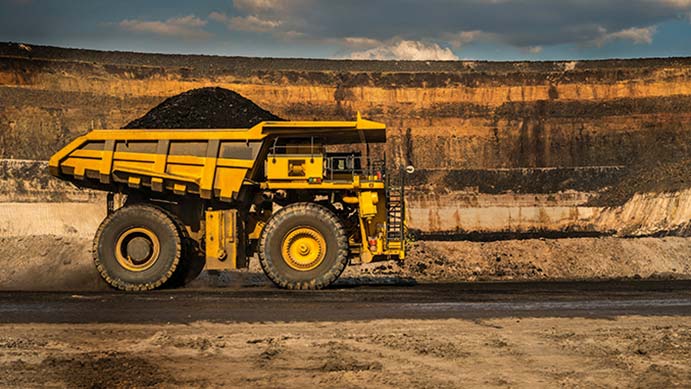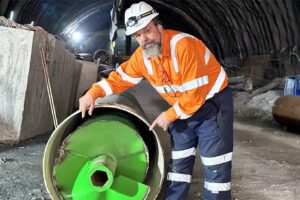By Alyssa Wedler (Marketing Communications Specialist)
Modular Mining Systems, Inc.
Mining companies have taken great strides to improve operator safety in recent years, and collision awareness systems will likely further this trend as mine sites globally strive to achieve a zero-incident workplace. But while new technologies can help this improvement effort, technology alone should not be a mine’s only line of defence in the goal to avoid vehicle collisions; sufficient training and operators that are fit for the job are also required to achieve total mine site safety.
Global Drivers for Improved Safety
Vehicle-to-vehicle collisions are among the top five causes of high-risk incidents in mines, resulting in equipment downtime, productivity losses, equipment- and personnel-related costs, injuries, and fatalities. These factors have generated a global motivation to focus on vehicle safety within mines, including increased regulation and legislation that will soon require mining organizations to have and use a safety system that can detect and minimize vehicle collisions.
South Africa, for example, recently passed legislation stating that any open-pit mine in which a collision risk is significant must include a means for any “diesel-powered trackless mobile machine” to automatically detect the presence of any other such machine within its vicinity, and upon detecting the presence of another machine, the operators in both vehicles shall be alerted to each other’s presence by means of an effective warning (such as an audible and/or visual cue).
In Australia, the New South Wales government defines the various levels of collision intervention capabilities that mine operators should consider when conducting a risk assessment and implementing a collision management system. The MDG-2007 Guideline for the Selection and Implementation of Collision Management Systems for Mining was drafted by the New South Wales government for use in that region but is quickly and widely becoming accepted as a global standard.
Common Challenges for Collision Awareness Systems on the Market Today
Several collision awareness systems are available to the mining industry today, all seeking to improve operator safety. But, at this point, many challenges still commonly exist that prevent them from ensuring a collision-free environment. For example, vehicle-to-vehicle communication is often delayed and unreliable with many existing technologies; traditional communications networks require that a signal hit numerous access points before reaching the operator or central office, which delays the notification and gives the operator very little chance to affect the situation.
But the challenge that seems most prevalent in today’s collision awareness systems lies in the frequency of “false positives” (alarms that occur when no collision threat is present). These false alarms, also known as “nuisance alarms,” often desensitize operators to actual collision risks, training them (in a sense) to adopt unsafe practices as a result of alarm annoyance; as operators realize the number and frequency of nuisance alarms, they begin to tune out all alarms. These false positives are very widespread and pose an extremely dangerous challenge for collision awareness systems in the mining industry.
Minimizing False Alarms
Modular Mining Systems’ approach to collision awareness focuses on minimizing false alarms while providing real-time information about potential high-risk incidents. The MineAlertTM Collision Awareness System (CAS) utilizes intelligent path prediction and scenario-based pattern recognition algorithms to filter out the potential non-risk-based nuisance and proximity alarms, helping to dramatically reduce the false alarm rate. This intelligent filtering capability, coupled with a simple user interface and near-instant peer-to-peer communications via a dedicated safety channel, enables operators to make split-second decisions and increases their situational awareness by providing critical information only when it matters.
One of the major challenges for a collision awareness system is the ability to predict a driver’s actual, near-term direction (one to five seconds out). Many systems on the market today use range and proximity sensors that alert operators when two vehicles are approaching each other, but a system that considers proximity, speed, and bearing alone will often alarm in normal operating conditions, even though no collision risk is imminent. A common example of this is when two haul trucks on the haul route are passing each other, going in opposite directions and in different lanes. This appears to be a collision risk due to the fact that the vehicles will, at some point, be in close proximity to each other, with what appears to be intersecting paths. If proximity, speed and general bearing are used alone in classifying the risk, the normal passing manoeuvre will trigger an alarm when no danger actually exists.
Some systems on the market today, including Modular’s, leverage path prediction technology, enabling them to accurately differentiate vehicles travelling in different lanes and also determine that their paths are not likely to intersect, acting as another filter against false alarms and providing a more trustworthy warning when an alert is issued; the path prediction algorithm works with collision scenario recognition to provide a strong filtering mechanism that alerts operators only when a true risk exists.
Communication is Key
Communication is the fundamental component of any safety system, as this defines how quickly and consistently information will be passed to the end user. Direct Short-Range Communications (DSRC) is a high-speed, low-latency peer-to-peer communications standard developed specifically for safety applications in the automotive industry. This communications technology utilizes a dedicated safety channel to avoid radio interference and prevent miscommunication as a result of incorrect channel usage or other operator-related radio errors and allows timely alarms and informative warnings to reach operators without delay. DSRC is a peer-to-peer communications system, so it operates in an environment with no wireless network infrastructure, allowing for full functionality on routes in and between mines, as well as for drivers commuting to a mine site in system-equipped light vehicles. DSRC is a standards-based safety protocol that helps insure forward adaptability as vehicle technology progresses.
Adopting a Holistic Safety Philosophy
Regardless of a collision awareness system’s ability to filter out false alarms and quickly communicate potential risks, technology alone should never be a mine’s only line of defence in the goal to avoid vehicle collisions. To create a truly safe working environment, mines need to look at safety as a mine-wide practice; a collision awareness system should simply complement and reinforce this established practice.
The first step toward a safe mine starts with an individual’s competency, ability, and performance:
- Is the individual properly trained for the job?
- Does this individual’s competency and ability match the job function they must perform?
- Is the individual’s performance capable of being tracked over time?
Proper operator training is an invaluable first step to site-wide mine safety. Additionally, implementing a fleet management system capable of tracking operator key performance indicators (KPIs) over time can help miners identify areas for operator improvement; some systems even allow mines to prevent operator log-in if an employee’s ID is not registered as “Qualified” for a specific piece of equipment.
After an individual has been thoroughly trained and is determined to be competent for his job function, the mine should assess whether he is fit for duty. If the best operator in the world is fatigued, or under the influence of drugs or alcohol, he is not fit for duty, and could pose a potentially catastrophic safety risk to himself or others in the mine. A fleet management system can reinforce a mine’s demand for fit-for-duty operators by interfacing to leading fatigue-management software to better identify an operator’s declining alertness before it results in collision and helps increase the operator’s awareness of his own fatigue level (in many cases, operators don’t realize how fatigued they really are).
One of the most important components of mine safety is situational awareness. A safe operator must be aware of everything around him, which can be tricky in a dynamic mine environment. Even a well-qualified, fit operator cannot avoid unknown risk, and should never rely primarily on technology to do so. The ultimate goal of an intelligent collision awareness system is to increase operators’ situational awareness, empowering them to make their own informed decisions to mitigate vehicle collisions. To meet this goal, the system’s display unit should use simple, easy-to-identify symbols and only alert operators when necessary, via near-instant communications like those provided by DSRC.
Lastly, the mine equipment itself must be safe for operation. Advanced equipment monitoring tools can monitor an entire fleet in real time, allowing maintenance personnel to identify and address potential issues before they become expensive, dangerous catastrophes.
A safe mine is not determined by the best technology, the best operators, or the best equipment. True mine safety is a complex combination of all these components, and more. Collision awareness technology for mines has advanced rapidly in recent years, and while technology should not be a mine’s first line of defence, the increased situational awareness these systems afford, combined with fit-for-duty operators who are sufficiently trained for the job, and healthy equipment, can undoubtedly help mines move towards a zero-incident workplace.
Read more about Safety Software














Add Comment